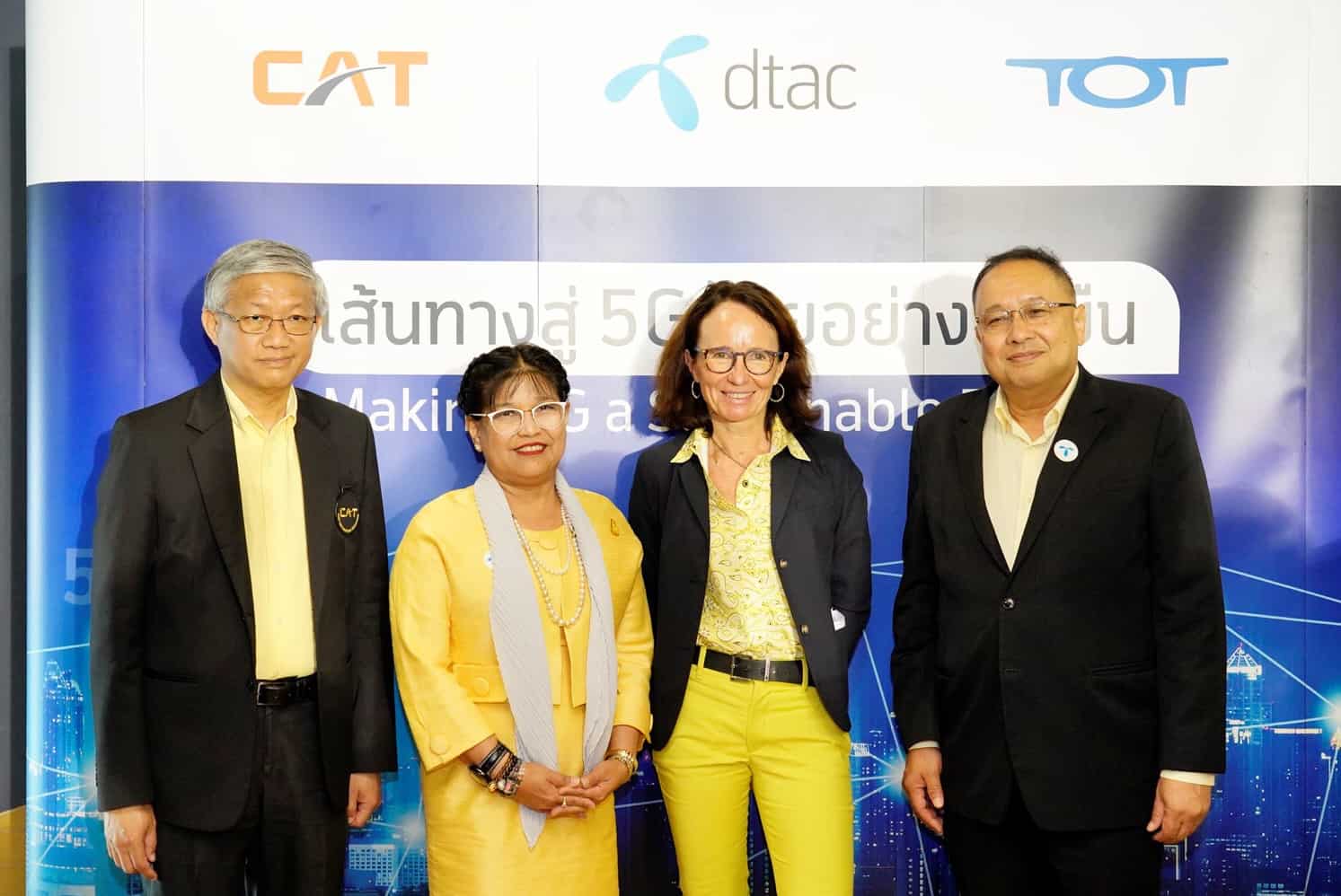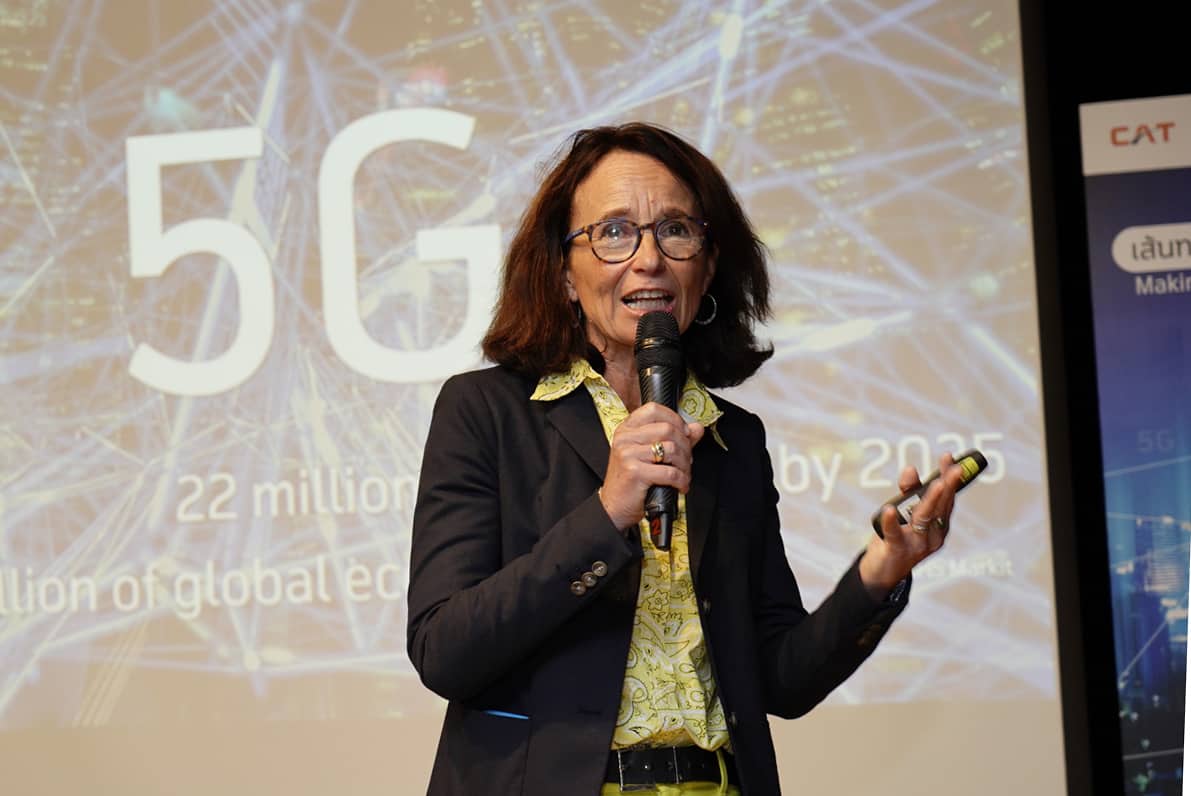- dtac will conduct both lab and live testing of 5G use cases at two sites
- TOT to test “Smart Poles” for a shared 5G smart city infrastructure
- CAT to use 5G-equipped PM2.5 sensor to help tackle air pollution crisis
April 1, 2019 – dtac has launched 5G testbeds at both Chulalongkorn University, in downtown Bangkok, and Kasetsart University’s Sriracha Campus in the Eastern Economic Corridor (EEC). The purpose is to test 5G use cases in collaboration with TOT and CAT, sharing resources and knowledge throughout the process. Testing equipment will also be provided by Ericsson, Huawei, and Nokia. In outlining Thailand’s path to 5G, dtac further urged the government to develop a spectrum roadmap comprising of high-, mid-, and low-band spectrum with a clear allocation timeline and spectrum refarming plan. Further recommendations include setting up an industry group to drive a sustainable 5G development plan, build 5G ecosystems, facilitate testing and identify key business opportunities.

Mrs. Wannaphorn Dephasadin Na Ayudhaya, Deputy Permanent Secretary, Ministry of Digital Economy and Society (DE), said, “The government and the Ministry of Digital Economy and Society recognize the importance of developing 5G, which requires strong collaboration from all concerned parties. The government stimulates and encourages industries to take part in 5G testing that applies new technologies, such as IoT (Internet of Things), AI (Artificial Intelligence), robotics, and cloud computing, thus creating future use cases. The ministry has also appointed a working group to oversee industry cooperation in 5G testing, develop the 5G roadmap, and coordinate with the NBTC to determine the future of 5G and a joint test plan.”
Ms. Alexandra Reich, Chief Executive Officer, Total Access Communication PLC or dtac, said, “To learn more about how 5G can benefit Thai society, we need to first identify relevant applications and use cases. This requires a strong collaboration between government, industry, and consumers. As part of forming a strong ecosystem to further explore the opportunities around 5G, dtac has joined forces with TOT and CAT to conduct testing and explore ways forward.”

BUILDING THE FIRST THAI TELECOMS PARTNERSHIP FOR 5G
5G will be driven by collaborations both within the telecom industry and across other industries. Within the telecommunications sector, dtac, TOT, and CAT each bring their own strengths to the partnership, covering a broad range of expertise on network systems, spectrum and regulatory aspects. This partnership is therefore a critical milestone in the roll-out of 5G in Thailand.
For the 5G testbed project, TOT will introduce a “smart pole,” a piece of infrastructure ideally suited to urban environments. It allows fast, reliable connections to IoT devices. The smart poles are being tested at Chulalongkorn University before being rolled out in additional public areas. In the future, this type of infrastructure can be shared with telecom providers, making 5G’s roll-out faster and more affordable.
Dr. Monchai Noosong, President of TOT public company limited, said, “If Thailand has a central agency that is responsible for smart poles, this can rapidly drive the expansion of the 5G network and digital infrastructure. It also can promote new service providers to enter the market fairly and equally. Infrastructure sharing not only reduces duplicated installation costs, but also provides people with access to fundamental information and technology.”
CAT Telecom Public Company Limited’s project, “PM2.5 Sensor for All,” will employ connected sensors in partnership with dtac to monitor air quality in the capital. Presently, air pollution is a crucial issue in the large cities. A report from the World Air Quality Index, indicates that the PM2.5 readings in Bangkok and Chiang Mai place them among the top ten most polluted cities in the world.
Colonel Sanpachai Huvanandana, President of CAT Telecom Public Company Limited, said “Our technology allows us to upload air quality index readings to the cloud in real-time. With the use of 5G networks, IoT can be upgraded to massive IoT (mIoT) and support a higher density of connected devices, which in turn can yield readings that are more accurate. In addition, all collected data from different areas can be processed and calibrated as big data on a cloud service, resulting in the most precise Thai air quality index ever.”
dtac has received the approval of the National Broadcasting and Telecommunications Commission (NBTC) to conduct 5G trials and 4G-5G compatibility trials. In addition to lab testing, the license covers live testing in areas such as Chulalongkorn University and Siam Square. The license also allows for remote testing, connecting the 5G testbed at Chulalongkorn University to the core network at the 5G EEC testbed at Kasetsart University, Sriracha Campus.
Ms. Reich said, “While 3G, 4G and IoT services are already available today using existing networks, 5G will allow operators to explore new opportunities with IoT and ultimately lead to a broader proliferation of IoT services, 5G will emerge from new use cases driven by industry collaborations. Since each country has different challenges, Thailand must complete its own analysis, testing and planning of 5G before we can see what our sustainable path to 5G is.”
The trial license from the NBTC covers mmWave on 26 GHz and 28 GHz, C-band, 3.5 GHz, 2600 MHz, 2300 MHz (under agreement with TOT), and 1800 MHz. The tests will therefore cover different spectrum bands and types of devices. The mmWave trial includes Enhanced Mobile Broadband (eMBB) and Ultra-Reliable Low-Latency Communication (URLLC) testing to evaluate the coverage performance. Moreover, the testing aims to improve the performance of the existing 4G network to ensure a smooth transition to 5G.
At the first stage of the 5G testbed, dtac will expand on its “Smart Farmer” solutions as a use case for 5G. The Smart Farmer solution uses IoT technology to enable Thai farmers to access real-time information and adopt precision farming solutions using drones and satellite. These digital solutions lead to higher yields, lower inputs (such as pesticides and fertilizers) and much higher revenue for farmers. 5G would allow higher-resolution video, longer battery life in IoT devices, and highly reliable remote piloting of larger drones.
CALL FOR SPECTRUM ROADMAP TO BE DEVELOPED PRIOR TO NEXT SPECTRUM AUCTION
Ms. Reich said, “Building a broad range of 5G use cases requires an equally wide range of spectrum, from to low- to mid- and high-band. Before considering any further auctions, operators need to see a comprehensive spectrum roadmap and the conditions under which it will be made available. Well-managed auctions must ensure not only fairness but also a reasonable valuation of the spectrum.”
dtac also identified three key prerequisites to 5G before launching commercial services:
1) Getting spectrum allocations right is critical – this starts with a roadmap
5G will rely on a mix of different bands required in different amounts. First and foremost, Thailand must publish a roadmap for all spectrum that will be made available over the coming years. This will provide transparency and allow mobile operators to plan their investments. Free trial spectrum can be provided for 5G use case testing between government and industry. Finally, the spectrum must be made available at prices that allow industry to acquire the amounts required to deliver on both the promise of 4G and the 5G future. This should not be understood as a call for more 5G spectrum to be put on the market prematurely, but rather should be seen as an opportunity to lay out a pathway for the release of relevant bands at the junctures whereby industry will need access to those bands.
2) Government must help to stimulate infrastructure investments
We must work to ensure that the necessary foundations are put in place to support the development of 5G. This includes ensuring that access to infrastructure and simplifying the process of infrastructure roll-out and rent processes are prioritised. An example of this is that three Norwegian ministries issued a national regulation effective January 2018 on laying cables along public roads (including tunnels and bridges). Previously each municipality had its own regulations and cost structure, which was bureaucratic, time consuming and expensive. NBTC should also look at how network sharing could accelerate Thailand’s ICT development. The network densification that will take place necessitates a clearer framework for building towers and locating small cells, which may include other existing public infrastructure such as telephone poles or street lamps.
3) Collaboration is at the centre of 5G development – experimentation must be at the core of the joint agenda between industry and government. If government can help to create demand for 5G, it will be rolled out. This includes the acceleration of smart city initiatives, and the use of 5G in the public sector. This can happen through consultation with industry to explore where use case interest intersects.

